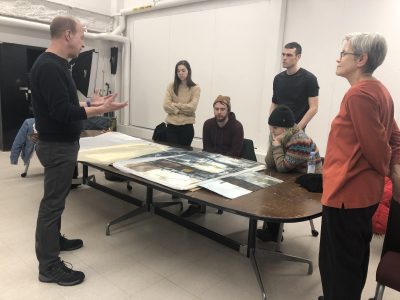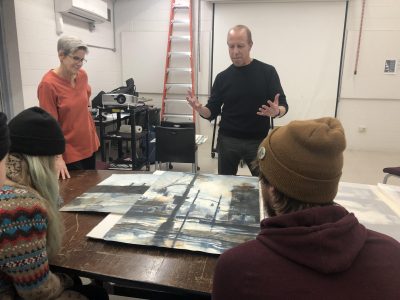Tim Saternow joined us at the Arena Gallery on February 19th to discuss watercolor painting.
Tim Saternow is an American painter whose watercolors explore the lost and forgotten areas on the edges of the urban scene. His paintings encompass the industrial streets of New York City, to the empty lands of Joshua Tree, California, to houses of Provincetown, MA. Tim got his BFA at SUNY Purchase in New York and his MFA from Yale University. Formerly, Tim was a Professor both at Carnegie-Mellon University from 1992 to 1996 and here at UConn from 1996 to 2006, where he taught graduate level Theater Design and Art Direction. When Tim was in his MFA program, he wasn’t taught how to create watercolors even though he was expected to use it as a medium and in film– this inspired him to teach it here at UConn when he was a professor. He loved creating watercolors so much that he decided to move to New York City to work full-time as a painter.
Tim came back to UConn on Tuesday, February 19th to talk to our MFA students about his journey as an artist, the process of creating his watercolors, how he mounts his work, and how to navigate the world of residencies and gallery showings post-MFA. His creation process begins with him making a value sketch that focuses on the light and dark, and negative and positive aspects of the scene. If the sketch interests him at this level, he moves forward to create a finer detailed sketch, then a colored sketch, and then the watercolor itself. When he makes the transition from colored sketch to watercolor, he first creates a grisaille (a gray monochrome painting). With the aim of deconstructing the image so as to not duplicate a photograph, he then splashes water and bursts of color on the painting. He works with those splotches and adds more local color until he feels like it’s done.
Tim has a series of work called PARK— each watercolor was of different parking garages in New York City and had the work ‘park’ somewhere in the painting. He advised the MFA students to market their artwork in terms of a theme, showing PARK as an example. He said the theme could even be the medium used to create the artwork, but that typically having a theme is the best way to get people interested in showing your work at galleries. He also advised them to focus on forming connections with others, as this was how he got to show work in many of the galleries his work has been in.
Tim’s work is so stunning and unique. Our MFA students were able to see his paintings first-hand and have the opportunity to ask him questions that resonated with where they’re at in their artistic careers. Thanks Tim!



